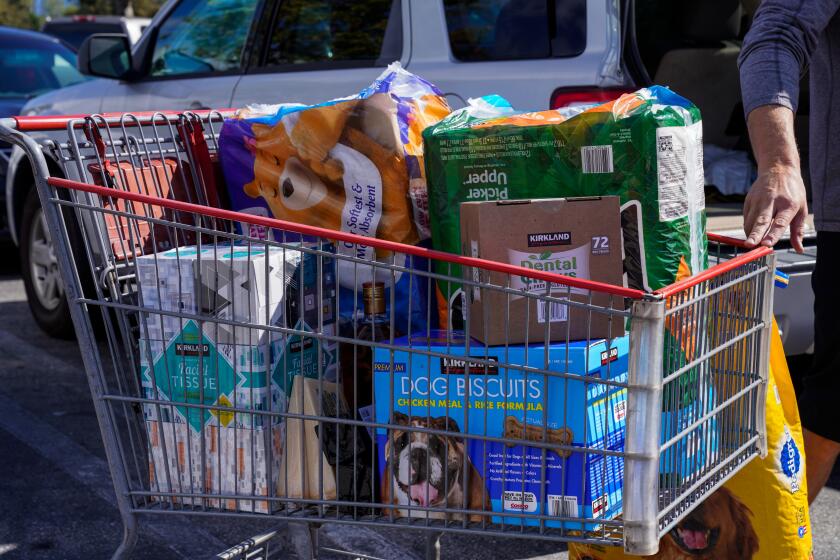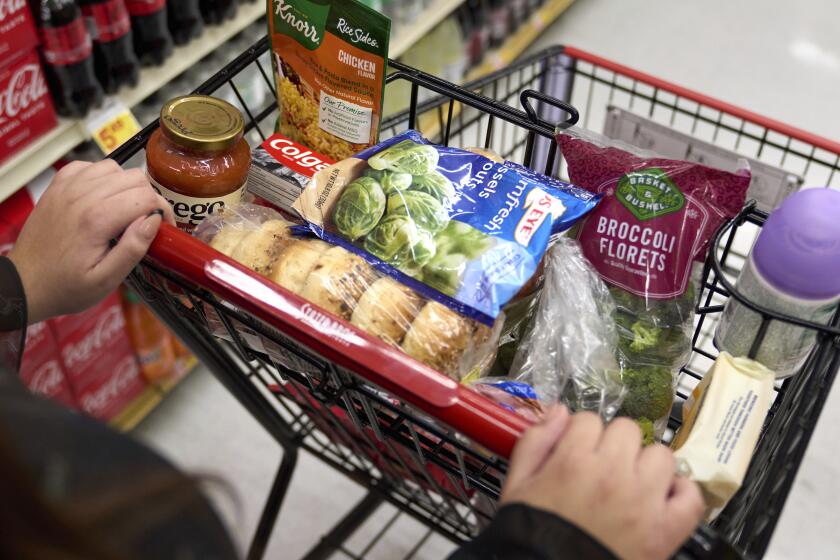U.S. inflation hits lowest point since early 2021 as prices ease for gas, groceries and used cars

- Share via
Squeezed by painfully high prices for two years, Americans have gained some much-needed relief with inflation reaching its lowest point since early 2021 — 3% in June compared with a year earlier — thanks in part to easing prices for gasoline, airline fares, used cars and groceries.
The inflation figure the government reported Wednesday was down sharply from a 4% annual rate in May, though still above the Fed’s 2% target rate. From May to June, overall prices rose 0.2%, up from just 0.1% in the previous month but still comparatively mild.
Even with Wednesday’s better-than-expected inflation data, the Fed is considered all but sure to raise its benchmark rate when it meets in two weeks. But with price increases slowing — or even falling — across a range of goods and services, many economists say they think the central bank could hold off on what had been expected to be another rate hike in September, should inflation continue to cool.
“It takes the second hike off the table, if that trend continues,” said Laura Rosner-Warburton, senior economist at MacroPolicy Perspectives. “They’re probably on hold for the rest of the year.”
On Wall Street, investors cheered the encouraging news, sending stock and bond prices higher. Investors have been eagerly anticipating the eventual end of the central bank’s rate increases.
The Fed has raised its benchmark rate by a substantial 5 percentage points since March 2022, the steepest pace of increases in four decades. Its expected bump this month will follow the central bank’s decision to pause its rate increases last month after 10 consecutive hikes.
Wednesday’s inflation data may lift hopes that the Fed will achieve a difficult “soft landing,” in which price increases fall back to 2% without causing a surge in unemployment or a deep recession. Last week, the government reported solid hiring in June, though it slowed compared with earlier this year. The unemployment rate ticked lower, from 3.7% to 3.6%, near a half-century low.
When the Fed began raising its key rate a year ago, many economists expected that unemployment would have to rise significantly to curb inflation. Though inflation isn’t yet fully tamed, some economists say they think it can fall to a level near the Fed’s 2% target earlier than they had expected.
Excluding food and energy prices, which tend to be more volatile, so-called core inflation was lower than economists had expected, with prices rising just 0.2% from May to June, the smallest monthly increase in nearly two years. Year-over-year inflation does remain relatively high, at 4.8%, but is down from a 5.3% annual rate in May.
In just the last two months, overall inflation, measured year over year, has slowed from nearly 5% in April to just 3% now. Much of that progress reflects the fading of spikes in food and energy prices that followed Russia’s invasion of Ukraine last spring. Inflation is now significantly below its peak of 9.1% in June 2022.
Inflation’s relentless surge didn’t merely persist in June. It accelerated. Here’s why.
Gas prices have fallen to about $3.54 a gallon on average, nationally, down from a $5 peak last year. Grocery prices have leveled off in the last three months and were unchanged from May to June. Milk prices, having dropped for a third straight month, are down 1.9% from last year.
Eggs, which had skyrocketed last year after an outbreak of avian flu decimated chicken flocks, have dropped to $2.22 a dozen — down more than 7% just in the last month. Egg prices had peaked at $4.82 in January, according to government data. Still, they remain above the average pre-pandemic price of about $1.60 a dozen.
Economists say inflation isn’t likely to keep falling at such a rapid pace. On a 12-month basis, inflation could even tick up in the coming months now that big drops in gas prices — they’re down 27% in the last year — have been achieved.
In particular, airfares plunged 8.1% just from May to June, hotel costs 2% and car rental prices 1.4% — sharp drops that aren’t likely to be replicated.
And the cost of some services are still rising and likely to stay high this year, potentially keeping core prices elevated. Auto insurance costs, for instance, have soared, and are up 16.9% from a year ago. Americans are driving more than during the pandemic and causing more accidents. Insurance is also costlier because vehicle prices are much higher than before the pandemic, and cars are therefore more valuable.
Restaurant prices are still moving up, having risen 0.4% from May to June and nearly 8% from a year earlier. Restaurant owners have had to keep raising wages to find and retain workers, and many of them are passing their higher labor costs on to their customers by raising prices.
Chrishon Lampley, owner of the wine brand Love Cork Screw, says more expensive restaurant prices have led her to cut back on taking prospective customers out for meals. Instead, she gives potential wine buyers small gifts.
The cost of printing labels for her wine bottles has nearly doubled in the last year, Lampley said, mostly because of higher labor costs. She’s reduced her travel costs as a result. Lampley now chooses extended-stay hotels with kitchens rather than regular hotels, and she rents smaller cars even though she often carts around cases of wine.
“Everything has just become way more frugal,” she said. “I’ve got to pull back.”
Federal Reserve Chair Jerome H. Powell and other Fed officials have focused their attention, in particular, on chronically high inflation for restaurant meals, auto insurance and other items in the economy’s sprawling service sector. It’s a big reason why several Fed policymakers were still talking earlier this week about the likelihood of two more rate hikes.
“We’re likely to need a couple more rate hikes over the course of this year to really bring inflation back into ... a sustainable 2% path,” Mary Daly, president of the Federal Reserve Bank of San Francisco, said Monday.
At the same time, Daly said she was “holding myself to ... extreme data dependence” and could shift her thinking based on incoming reports. There will be two more inflation reports — for July and August — before the Fed meets in September.
Some drivers of higher prices are likely to keep fading and pull down inflation in the coming months. Used-car prices sank 0.5% from May to June, after two months of big jumps. New-car prices, too, have begun to ease as a result, and were unchanged from May to June.
In June, used-vehicle prices paid by dealers were down 5.6% from a year earlier, helping to cool inflation, according to data gathered by Black Book, which monitors prices. But used vehicles are still comparatively pricey: Dealers are paying almost 70% more for them than in June 2019, before the pandemic began. The average list price offered by dealers to consumers was $28,850 last month.
Alex Yurchenko, chief data officer for Black Book, said he expects prices paid by consumers to keep falling through year’s end, contributing to declining inflation. But they aren’t expected to drop dramatically. Typically, prices fall in the second half of the year, then rise in the spring as the car-buying season begins.
“We expect a return to some kind of normality,” Yurchenko said.
Supplies of new vehicles are rising, and prices are dropping slightly. As a global shortage of computer chips wanes, automakers have accelerated production. New-vehicle prices peaked in December but fell 3% to $45,978 last month, according to estimates from J.D. Power.
And rental costs, a huge driver of inflation, are expected to keep declining, as builders continue to complete the most new apartment units in decades. Rising housing costs have driven more than two-thirds of the increase in core inflation in the last year, the government said, so as that increase fades it should steadily lower overall inflation.
Prices first surged two years ago as consumers ramped up their spending on items such as exercise bikes, standing desks and new patio furniture, fueled by three rounds of stimulus checks. The jump in consumer demand overwhelmed supply chains and ignited inflation.
Many economists have suggested that President Biden’s stimulus package in March 2021 intensified the inflation surge. At the same time, though, inflation also jumped overseas, even in countries where much less stimulus was put in place.
Consumers are switching grocery stores, brands and ingredients as they try to cope with the cost of food.
AP writer Tom Krisher contributed to this report.
More to Read
Inside the business of entertainment
The Wide Shot brings you news, analysis and insights on everything from streaming wars to production — and what it all means for the future.
You may occasionally receive promotional content from the Los Angeles Times.












